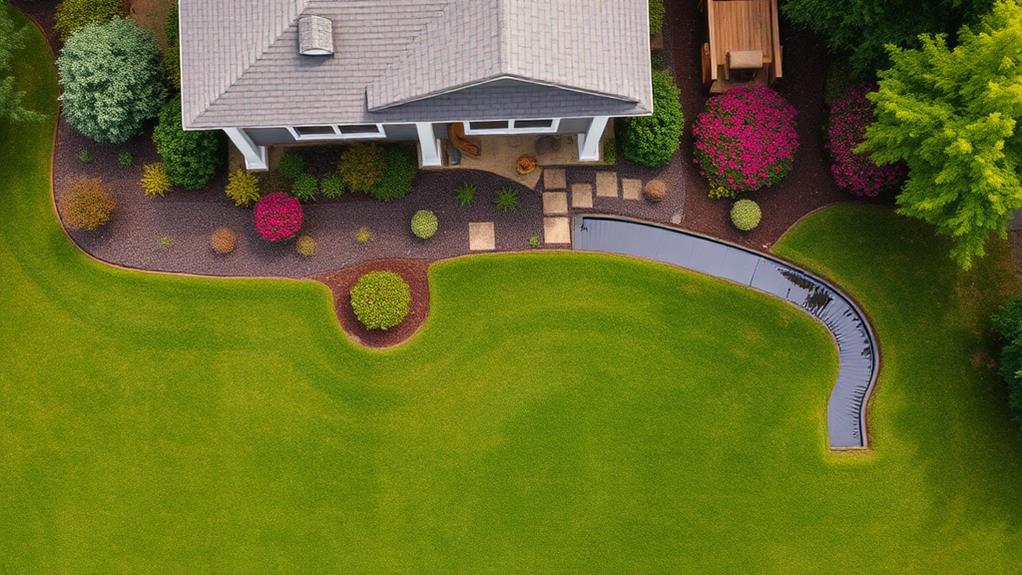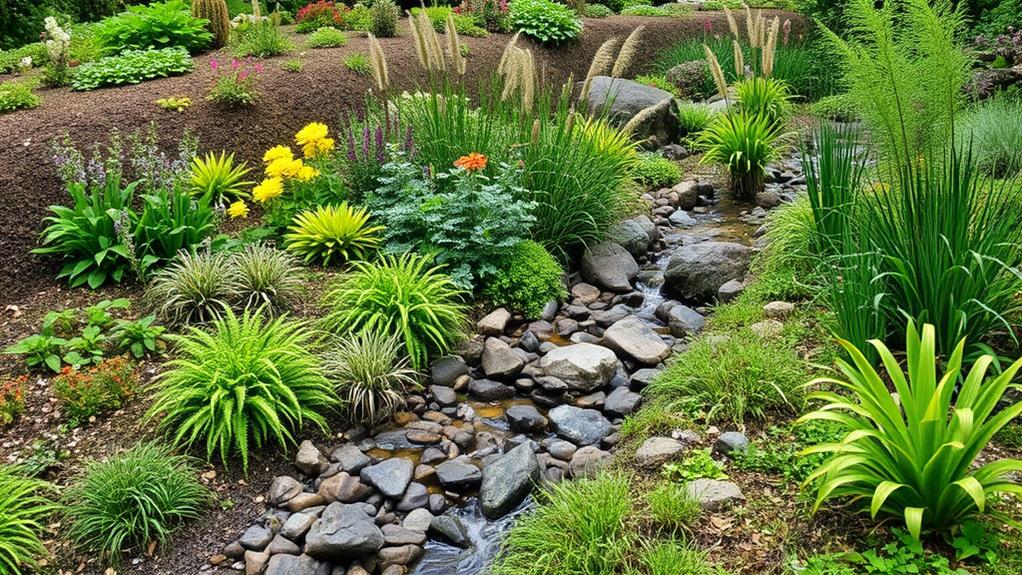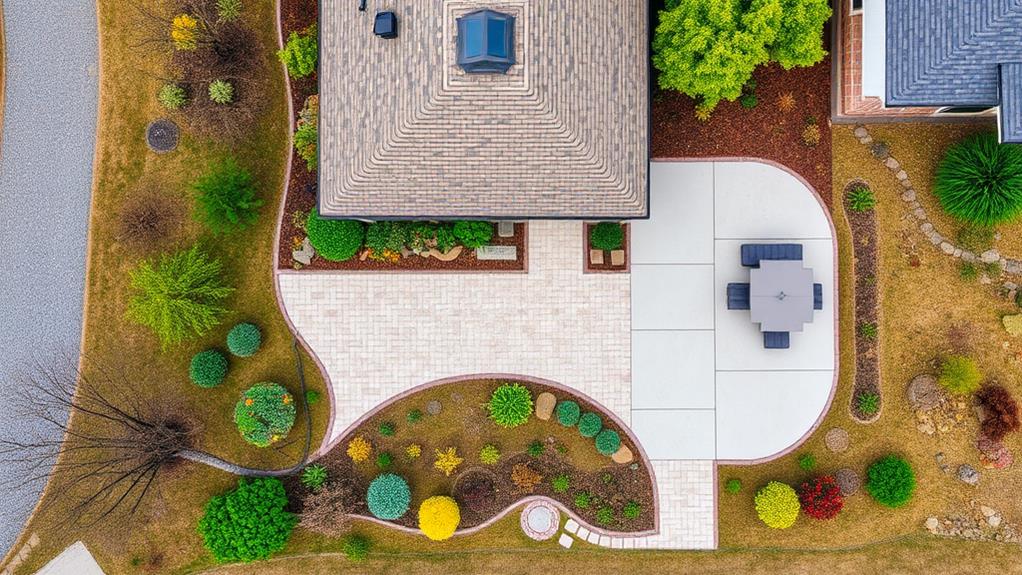Effective landscaping techniques can significantly reduce standing water around your home. Proper grading and sloping direct water away from the foundation, while French drains collect and redirect excess moisture. Water-absorbing plants naturally soak up excess water, and rain gardens capture and filter stormwater runoff. Permeable hardscaping solutions allow water to infiltrate the soil rather than pooling on surfaces. These methods not only prevent standing water but also contribute to overall water management and environmental health. By implementing a combination of these techniques, homeowners can create a functional and attractive landscape that effectively addresses drainage issues. Exploring these solutions further reveals their long-term benefits for your property.
Proper Grading and Sloping

Proper grading and sloping lay the foundation for effective water management in landscaping. This technique involves carefully shaping the land to direct water away from structures and prevent pooling. The general rule is to maintain a slope of at least 6 inches over a distance of 10 feet from the foundation of buildings. This gentle incline ensures that water flows away from the house rather than towards it.
To achieve proper grading, start by identifying low spots in your yard where water tends to collect. These areas should be filled and leveled to match the surrounding terrain. Pay special attention to the soil immediately adjacent to your home's foundation, ensuring it's slightly elevated and slopes away from the structure. For larger properties, consider creating swales – shallow, elongated depressions that channel water to designated drainage areas.
When implementing grading changes, use a mix of topsoil and compost to promote healthy grass growth and improve soil drainage. Avoid compacting the soil during the process, as this can impede water absorption. Regular maintenance, including addressing erosion and settling, is crucial to maintaining effective grading over time.
Installing French Drains
While grading and sloping provide an effective foundation for water management, some landscapes may require additional drainage solutions. Installing French drains is an excellent option for areas prone to persistent standing water. A French drain consists of a perforated pipe surrounded by gravel, which collects and redirects excess water away from problem areas.
To install a French drain, begin by digging a trench that slopes away from the house, typically at a 1% grade. Line the trench with landscaping fabric to prevent soil infiltration, then add a layer of gravel. Place the perforated pipe on top of the gravel, ensuring it maintains the proper slope. Cover the pipe with more gravel, then wrap the fabric over the top before backfilling with soil.
French drains can be customized to suit various landscape needs. For example, they can be connected to downspouts to manage roof runoff or extended to create a network of drainage channels throughout the property. When properly installed, French drains effectively prevent standing water, protect foundations, and maintain a dry, healthy landscape. Regular maintenance, such as clearing debris from the drain's entry points, ensures long-term functionality.
Water-Absorbing Plants

Frequently overlooked in landscaping solutions, water-absorbing plants offer a natural and aesthetically pleasing approach to managing excess moisture. These plants, often referred to as hydrophytes, have adapted to thrive in water-rich environments and can effectively absorb excess water from the soil.
When selecting water-absorbing plants, consider native species that are well-suited to your local climate and soil conditions. Trees such as willows, bald cypress, and river birch are excellent choices for larger areas, as their extensive root systems can absorb significant amounts of water. For smaller spaces, consider perennials like joe-pye weed, swamp milkweed, or cardinal flower.
Ornamental grasses, such as sedges and rushes, are particularly effective in absorbing water while adding texture to your landscape. Ferns, like the cinnamon fern or royal fern, thrive in moist conditions and can help reduce standing water in shaded areas.
When incorporating water-absorbing plants into your landscape, group them in low-lying areas or create rain gardens to maximize their effectiveness. By strategically placing these plants, you can create a functional and visually appealing solution to water management while promoting biodiversity in your yard.
Creating Rain Gardens
Rain gardens serve as natural water catchment systems, designed to capture and filter stormwater runoff from impervious surfaces like roofs, driveways, and patios. These shallow depressions in the landscape are strategically positioned to collect water and allow it to slowly infiltrate into the ground. By implementing a rain garden, homeowners can effectively reduce standing water issues while also contributing to groundwater recharge and pollution reduction.
To create a rain garden, select a location that is at least 10 feet away from building foundations and naturally receives runoff. Excavate the area to a depth of 4-8 inches, creating a bowl-like shape with gently sloping sides. Improve soil drainage by mixing in compost and sand. Choose native plants that tolerate both wet and dry conditions, such as sedges, rushes, and certain wildflowers. These plants help absorb excess water and filter pollutants.
Install an overflow mechanism, such as a rock-lined channel, to direct excess water during heavy rain events. Regularly maintain the rain garden by removing debris, weeding, and pruning plants to ensure optimal performance and aesthetic appeal.
Permeable Hardscaping Solutions

Permeable hardscaping solutions offer an effective approach to managing stormwater runoff and preventing standing water in landscaped areas. These innovative materials allow water to pass through their surface and infiltrate the soil beneath, reducing surface runoff and promoting natural groundwater recharge.
Common permeable hardscaping options include:
- Permeable pavers: Interlocking units with gaps that allow water to seep through
- Porous asphalt: A specially designed mixture that allows water to filter through its surface
- Pervious concrete: A material with a high porosity that enables water absorption
- Gravel or crushed stone: Natural materials that provide excellent drainage
When implementing permeable hardscaping, proper site preparation is crucial. This includes assessing soil conditions, installing an appropriate base layer, and ensuring proper slope for drainage. Regular maintenance, such as sweeping and vacuuming, is necessary to prevent clogging and maintain permeability.
Permeable hardscaping can be used for various applications, including driveways, patios, walkways, and parking areas. By incorporating these solutions into your landscape design, you can effectively manage water runoff, reduce the risk of flooding, and contribute to sustainable water management practices.
Frequently Asked Questions
How Often Should I Inspect My Property for Standing Water Issues?
Regular property inspections for standing water issues are crucial. Conduct thorough checks at least monthly, with additional inspections after heavy rainfall or snowmelt. Pay special attention during spring and fall when water accumulation is more likely to occur.
Can Standing Water Problems Affect My Home's Foundation?
Standing water near your home can indeed impact its foundation. Research shows prolonged exposure to moisture can lead to soil erosion, settlement, and structural damage. Regular inspections and proper drainage are crucial to protect your home's foundation from water-related issues.
Are There Any DIY Tests to Check Soil Drainage Capacity?
Several DIY tests can assess soil drainage capacity. The percolation test involves digging a hole, filling it with water, and measuring how quickly it drains. The ring infiltrometer test uses a cylinder to measure water absorption rates.
What Are the Best Materials for Creating Swales in My Yard?
The best materials for creating swales in your yard include native soil, gravel, and river rocks. Permeable landscaping fabric can be used as a base layer. Vegetation like native grasses and shrubs can stabilize the swale and enhance its effectiveness.
How Do Local Building Codes Affect Water Management Landscaping Projects?
Picture a maze of regulations: Local building codes significantly impact water management landscaping projects. They dictate permissible techniques, materials, and drainage solutions. Compliance is crucial, often requiring permits and inspections before implementing any major water-diversion strategies on your property.
Conclusion
In conclusion, effective landscaping techniques play a crucial role in preventing standing water around residential properties. By implementing proper grading, installing French drains, incorporating water-absorbing plants, creating rain gardens, and utilizing permeable hardscaping solutions, homeowners can significantly reduce water accumulation. These methods not only enhance the aesthetic appeal of the landscape but also mitigate potential health hazards and structural damage associated with standing water. As Benjamin Franklin once said, "An ounce of prevention is worth a pound of cure," and this adage holds true for water management in modern landscaping practices.

